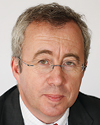...with thousands of water tubes. The vast fabrication recently lay wrapped in plastic at St. Marcel, awaiting transfer along waterways for shipment from Marseilles, 440 kilometers to the south.
Anticipating growing demand, Areva last month announced a $100-million investment to expand St. Marcel’s capacity by 60% to produce parts for 2.7 reactors a year from 2012. To ensure supplies of large forgings, it has committed a similar sum to work with steel ingots of over 500 tonnes at its facility in Le Creusot, 40 km from the component plant.
The Le Creusot plant will end the global monopoly in such large forgings held by Japan Steel Works Ltd., Tokyo. But it will meet only part of Areva’s forecast needs. To maintain supplies to at least 2016, the reactor builder last November signed an agreement with JSW, sealing the deal by acquiring a small shareholding in the Japanese company.
Even with its planned expansion of component making at St. Marcel, Areva late last year announced a $365-million U.S. investment in a plant in Newport News, Va. The plant, next to Northrop Grumman Shipbuilding’s shipyard, will be a small version of St. Marcel, able to produce components for one reactor a year, says Christopher Levesque, president and general manager of Areva Newport News LLC.
Areva spent 18 months looking for a U.S. site, turning down three other locations, says Levesque. In an equal joint venture with Northrop Grumman Shipbuilding, Areva aims to have the plant working in 2012. Newport News and the state provided incentives, but local shipbuilding skills were key to the choice, says Levesque. “It literally takes decades to work up that kind of heavy-metal workforce....It’s a competence that doesn’t exist in many U.S. communities.”
Building powerplants is at the heart of Areva’s business, but the company is active in the whole nuclear cycle, from uranium mining in Africa to high-level waste management in France.

One of Areva’s biggest current investments is a $4-billion centrifuge uranium-enrichment facility to replace an obsolete gaseous diffusion plant at Tricastin, near Bollène, north of Avignon. Each of Tricastin’s 1,400 current gas diffusers consumes enough power to drive a high-speed train, says Gérard Perrat, executive vice president of Areva’s Société D’Enrichissement du Tricastin (SET). SET’s new facility will consume 98% less power, ending the plant’s reliance on four nearby 900-MW EdF nuclear reactors.
Enrichment at the modular centrifuge plant is due to start late this year and build up to full capacity by 2016. Rated at 7.5 million separative work units (SWU), the plant will have enough capacity to produce uranium for all France’s 58 reactors plus 40 more. (SWU is a measure of work expended during enrichment.)
Rather than develop its own centrifuges, Areva played it safe by paying some $670 million to equally share proven technology developed by URENCO, which is owned equally by Germany, the Netherlands and the U.K. Both URENCO and Areva are using the same centrifuge design for their new U.S. plants.
URENCO began building America’s first 3.5-million SWU centrifuge plant...










Post a comment to this article
Report Abusive Comment